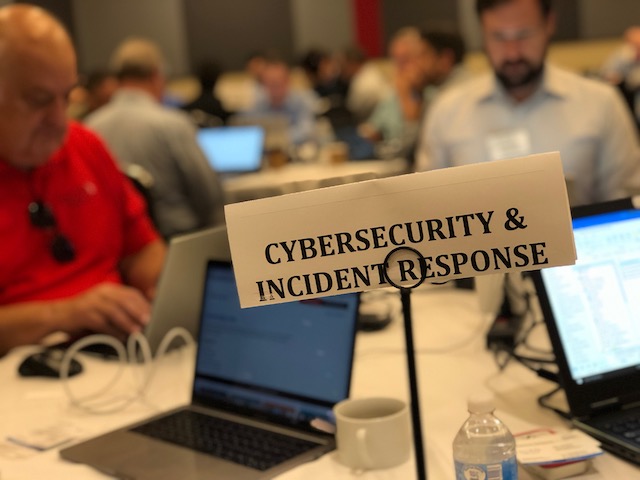Last week in San Antonio, Texas, about 150 DISTRIBUTECH stakeholders convened to discuss industry trends, best practices for marketing and sales in the utility industry and set the educational agenda for the 2020 event.
 Britt Burt, VP of Power Industry Research with Industrial Information Resources (pictured right) presented an overview of all of the power generation and T&D industry projects or upgrades planned over the next three years – pulled form from the IIR database. In total, worldwide energy companies will be spending billions on upgrading T&D assets and building new infrastructure over the next 4 years.
Britt Burt, VP of Power Industry Research with Industrial Information Resources (pictured right) presented an overview of all of the power generation and T&D industry projects or upgrades planned over the next three years – pulled form from the IIR database. In total, worldwide energy companies will be spending billions on upgrading T&D assets and building new infrastructure over the next 4 years.
Jennifer Runyon (that’s me) presented 10 trends in the utility industry and gave specific examples of how utilities are embracing these trends and working to create innovative solutions to the challenges they present.
They are:
- Aging infrastructure
- Aging people
- Extreme weather events
- Renewable energy
- Decentralized/distributed energy
- Customer expectations
- Smart homes and buildings
- Cybersecurity
- Electrification of transportation
- Even newer stuff – blockchain, digitalization
 On the topic of aging workforce, she read the following quote from the Department of Energy’s DOE’s Transforming the Nation’s Electricity Sector, released in January 2017:
On the topic of aging workforce, she read the following quote from the Department of Energy’s DOE’s Transforming the Nation’s Electricity Sector, released in January 2017:
The electricity system of the 21st century will require an adaptable and flexible workforce with additional areas of expertise and capabilities than the current workforce. The integration of variable renewable sources, storage systems, smart grid, and demand management will require new training and skillsets. Sector engineers need to have well-developed expertise in traditional topics such as electrical engineering, while also possessing knowledge of information technology, communications, and other relevant topics. Maintaining existing training programs for the legacy systems while also focusing on the skillsets of tomorrow’s workers will be a unique challenge.
The emphasized part of the quote (which I added) is important because it highlights DISTRIBUTECH’s raison d’être. The event strives to provide educational content that helps all workers do their jobs today while also making them aware of, and knowledgeable about, what is coming down the pike that could challenge their operations in the future.
The event also showcases all of the innovative companies in the space that are providing the R&D necessary to meet those challenges. (Need information about exhibiting? Click here.)bysxszvavyeqruyccfwesbexrb
Setting the Educational Agenda
 Day 2 was set aside for the DISTRIBUTECH technical committee. About 75 of the event’s 90 committee members got together in one room to review, discuss, and debate all 650 abstracts that were submitted by people interested in speaking at the show.
Day 2 was set aside for the DISTRIBUTECH technical committee. About 75 of the event’s 90 committee members got together in one room to review, discuss, and debate all 650 abstracts that were submitted by people interested in speaking at the show.
The committees, which are divided into subcommittees based on their areas of expertise, put together sessions for the summit (1.5-hour sessions in conference rooms) and the knowledge hubs (30-minute sessions in the exhibit hall). Once the whole program has been finalized, it will go live at this link.
 Big ideas that surfaced and will be covered at DISTRUBUTECH include innovations in DERMS technology, cybersecurity, digitalization of assets and asset management among many, many other important themes.
Big ideas that surfaced and will be covered at DISTRUBUTECH include innovations in DERMS technology, cybersecurity, digitalization of assets and asset management among many, many other important themes.
Committee members involved in Initiate!, the program for startups in the utility space, also met to discuss how to improve the program in 2020. The group expects to launch its application form — which allows startups to apply to exhibit at DTECH for a reduced fee, present their companies to potential financiers “shark-tank style,” and compete against each other to win awards — in August. (Our Initiate! entry form for POWERGEN is live and can be accessed at this link.)
The utility university (UU) committee also met to debate the abstracts that were submitted by potential instructors. The UU’s at DTECH are 4-hour classes that take place on Monday, January 27, which is the day before DTECH officially begins.
The photos show some of the highlights of the two-day event.




![♬ Como Eliminar Quitar Silbidos Dereverb Eco en Adobe Audition CC 2015 [Edicion Profesional]](http://www.ecobuild.club/wp-content/uploads/2019/07/1562086692_maxresdefault-75x75.jpg)